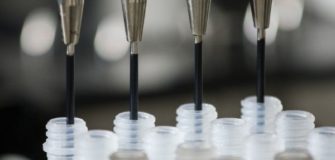Yale scientists repair injured spinal cord using patients’ own stem cells
Share
Intravenous injection of bone marrow-derived stem cells (MSCs) in patients with spinal cord injuries led to significant improvement in motor functions, researchers from Yale University and Japan report in the Journal of Clinical Neurology and Neurosurgery.
For more than half of the patients, substantial improvements in key functions — such as the ability to walk, or to use their hands — were observed within weeks of stem cell injection, the researchers report. No substantial side effects were reported.
The patients had sustained, non-penetrating spinal cord injuries, in many cases from falls or minor trauma, several weeks prior to implantation of the stem cells. Their symptoms involved loss of motor function and coordination, sensory loss, as well as bowel and bladder dysfunction. The stem cells were prepared from the patients’ own bone marrow, via a culture protocol that took a few weeks in a specialized cell processing center. The cells were injected intravenously in this series, with each patient serving as their own control. Results were not blinded and there were no placebo controls.
Yale scientists Jeffery D. Kocsis, professor of neurology and neuroscience, and Stephen G. Waxman, professor of neurology, neuroscience, and pharmacology, were senior authors of the study, which was carried out with investigators at Sapporo Medical University in Japan. Key investigators of the Sapporo team, Osamu Honmou, and Masanori Sasaki, both hold adjunct professor positions in neurology at Yale.
Kocsis and Waxman stress that additional studies will be needed to confirm the results of this preliminary, unblinded trial. They also stress that this could take years. Despite the challenges, they remain optimistic.
“Similar results with stem cells in patients with stroke increases our confidence that this approach may be clinically useful,” noted Kocsis. “This clinical study is the culmination of extensive preclinical laboratory work using MSCs between Yale and Sapporo colleagues over many years.”
“The idea that we may be able to restore function after injury to the brain and spinal cord using the patient’s own stem cells has intrigued us for years,” Waxman said. “Now we have a hint, in humans, that it may be possible.”
Materials provided by Yale University. The original text is written by Lakshmi Bangalore. Note: Content may be edited for style and length.
Journal reference: Osamu Honmou, Toshihiko Yamashita, Tomonori Morita, Tsutomu Oshigiri, Ryosuke Hirota, Satoshi Iyama, Junji Kato, Yuichi Sasaki, Sumio Ishiai, Yoichi M. Ito, Ai Namioka, Takahiro Namioka, Masahito Nakazaki, Yuko Kataoka-Sasaki, Rie Onodera, Shinichi Oka, Masanori Sasaki, Stephen G. Waxman, Jeffery D. Kocsis. Intravenous Infusion of Auto Serum-expanded Autologous Mesenchymal Stem Cells in Spinal Cord Injury Patients: 13 Case Series. Clinical Neurology and Neurosurgery, 2021; 106565 DOI: 10.1016/j.clineuro.2021.106565
Based on a city where the mountain meets the sea and where antique houses line the streets, my mind is free to wonder, to wander and to write.




